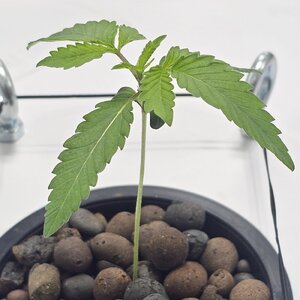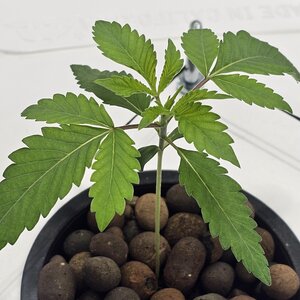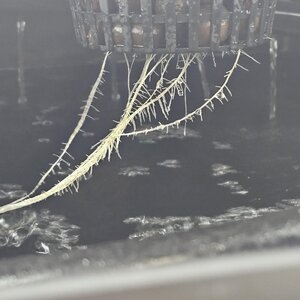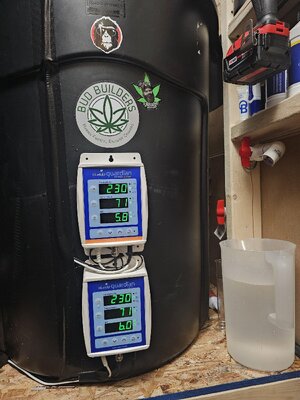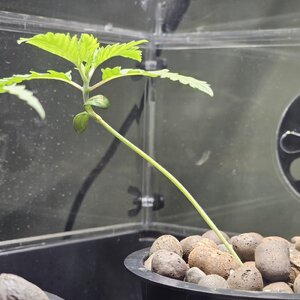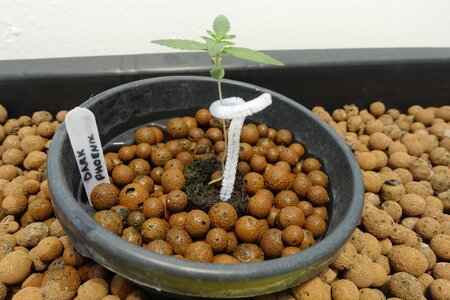Thats shows very similar symptoms of light stress.
Wavey and spiky leaf edges with raised swollen intervenal tissue which is a transpiration issue not always light related but can be VPD and root pressure also. But light drives transpiration. A plant with too little light doesn’t fall over.
Wind would have to be crazy high to keep a plant pushed sideways IMO.
I can also see the high red hue in the picture.
Stretch is a combination of things not just one thing. Genetics do play a big role but so does temp, light spectrum and PGR’s
Right at sprout if you have a 4-8000k color temp of light it makes a huge difference.
Your light intensity per distance is very different than his. Remember intensity at the leaf is different when you have the same wattage over a wider area. Its just not comparable
Most recent grow with light getting dialed in better any fall overs were avoided compared to that grow.
Same group above but a week later. Nothing adjusted other than light output increase to 70-70.
I agree a plant can't be toppled by a breeze but a soft stem seedling without enough roots anchoring it down can fall over if breathed on too hard in a loose medium.
I wouldn't focus too much on the color of my pics as my Ipad does not equal reality at all.
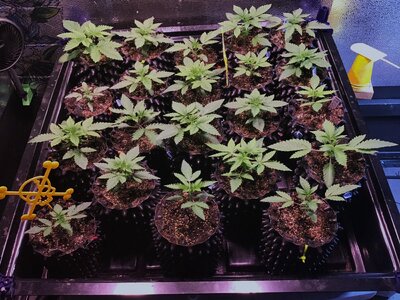
This grow was actually a second test of CLW's newish Spectramax 1000 which is a demon of a light to work with so there were bound to be mistakes and missteps. Like back in 2016-19, growers are left to figure it out on their own as there is no user guide for it.
Then later dual 550s are added to the array.
This grow was also a genetic pheno hunt.
With this Spectramax I can pretty much dial up any kelvin temp I want within reason and seriously make it rain photons at a level not many lights on the market can do. It's very ez to beat a plant into submission with this thing unlike the Solar System series which are super user friendly.
I can't get it to do a good finishing spectra at 8000-10,000K and that's about it but anything between 2500 and 4500 is available.
Given how many plants I've grown with all the different CLW lights and especially recent models it's ez for me to dial up a singluar or array of spectrum, use a Pulse Pro to diagnose that spectrum, it's DLI, and PPFD and also break down what colors are making up that PPFD.
With that data I've been able to predict how it will grow a plant then it's just a matter of seeing if the data matches what the plants are doing. It does 9/10 times with mutants being the wildcards. That's what I did this morning on Grumps low settings and it raised an alarm of weak light.
I pay very little mind to what leaves are doing at this early stage unless it's something radically weird.
Really the only thing I'm looking for is them to look as normal green as possible, not be infested or have mildew, and not be mutated.
Baby growth is cut away at upcan so concern over what single and three blade baby leaves look like are really not something I'll make any adjustment for in order to get them to look perfect. They're only needed for 15 days if that before they're cut off.
My main concern is fast growth rate and temp not getting too hot and out of control. And I can guarantee my defintion of too hot is very different from yours and probably every grower on this forum. Everything else is secondary or ignored until I'm stacking flowers.
So if I see a leaf that may be wavy from heat or any other deformity early on it will be let go because it will either be cut off when cleaned up for upcan or there's going to be 1000s of more leaves coming out and I'm not going to worry about every leaf in the crop looking perfect. Like it may not be ideal today but in a week it really wont matter at all.
10 days later they're culled, upcanned, clipped, and flipped. Several mutants were allowed to remain simply because they were interesting specimens. Some are shock stressed from the upcan and having roots exposed but in 24 hours all will be perky again with DLI increased to 30.
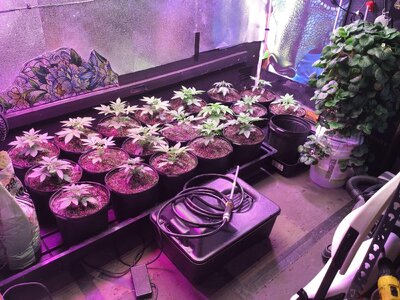
And nearing harvest with a 45 DLI and 1002 PPFD but it could be pushed up to 1700PPFD. I couldn't tell you what the kelvin temp is but if I guessed it would be around 3000K then up to around 3500 with the SS550s added in give or take a couple hundred kelvin.
Biggest focus for me really is leaf to calyx ratio, flower density, and most of all oil production. Like I pay no mind to tacos or waves as long as they get loaded with frost. Burnt tips however are a pet peeve because that cuts into oil production ans is why I feed at very low rates to prevent burns. From time to time there will be extreme stretching in some strains and next to no stretch for others. This room was built to handle such oddities since they're quite common among hybrids
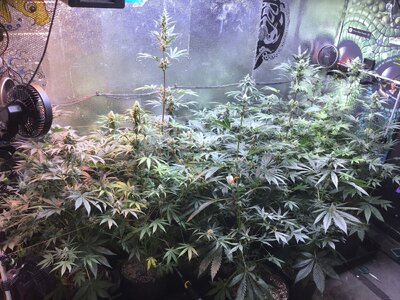
During this stage I really don't look that much into what leaves are doing with the exception of something like pest inspections and maybe counting blades. I don't chase VPD because it's like herding cats and I tend to focus more on heat than anything because if that's not in control then everything else will be outa wack.
As long as leaves don't fall off early, wilt, go raptor claw, or burn up I'm pretty happy with them.
My sole focus really is 100% flowers especially with flipping plants at around 20 days old from dry seed. I don't veg plants past the first set of 5 point leaves and those leaves that are on the plant at flip will be meaningless as the grow progresses.
So everything I do is to push a crop hard as it can be pushed. I've told others this isn't a garden but more of a gulag. Temps, RH, co2, and VPD and everything else are pretty much always severely less than ideal especially with a room running in the high 90s. If conditions are ideal it's because I got lucky with Mother Nature that day.
Leaf temps on sprouts can sometimes hit mid 80s. Germination temps are always well above 80. Flowering temp is the only time I exert control and use an AC to cool the joint down. Air flow is well above and beyond normal here as well as water uptake. Dual exhaust, 8 small air movers, two large air movers and probably more I'm not counting. What's done here could and has been considered impossible by many but I see these things as mere hurtles that can be overcome quickly and still haul a high quality harvest. If I was to sum up this way of farming ganja as a book it would be a coloring book and I color outside the lines on every picture.







